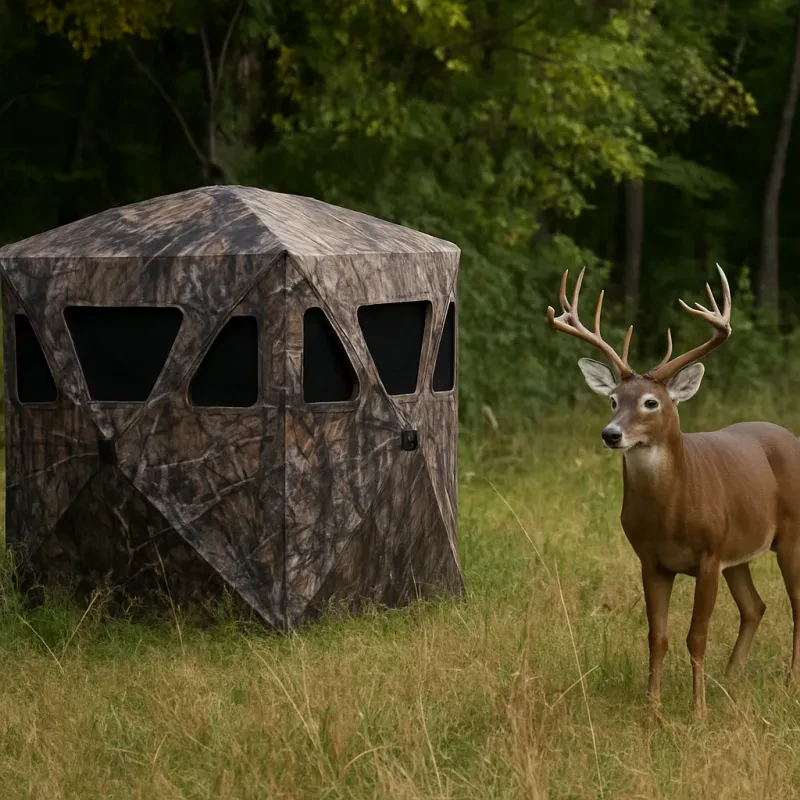When it comes to effective hunting, choosing the right location for your blinds can make all the difference. One of the most common mistakes with hunting blinds is placing them in areas that don’t have sufficient wildlife activity. Before you set up, take some time to scout the area. Look for trails, feeding spots, and areas with fresh signs of animal activity. This will increase your chances of a successful hunt and ensure you're not wasting time in the wrong spot.
Another important factor to consider is the wind direction. Animals have an excellent sense of smell, and if they catch your scent, they are likely to avoid the area. Ensure that your blind is placed downwind from where you expect the animals to come from. By paying attention to wind patterns, you can avoid one of the major common mistakes with hunting blinds that many hunters make, which can lead to spooking the game before you even have a chance to see them.
Additionally, think about the surroundings and how they might affect your visibility and comfort. Avoid placing your blind near areas with heavy brush or tall grass that could limit your view. A clear line of sight is essential for spotting animals early and getting a good shot. Furthermore, consider natural cover provided by trees or hills, which can help you blend into the environment and remain undetected by animals. Balancing accessibility with concealment can help you create a more effective setup.
Ensuring Proper Setup and Stability
Another important factor in setup is choosing the right location. Setting up your blind in a spot that provides a clear line of sight while also offering concealment is key. Look for natural terrain features like trees, bushes, or hills that can help shield your blind from view. A common mistake with hunting blinds is placing them in open areas where deer or other game can easily spot them, making them hesitant to approach.
Additionally, consider the stability of the ground where you are placing your hunting blind. Soft or uneven terrain can lead to a wobbly structure, which can be distracting and uncomfortable during those long hours of waiting. To avoid this common mistake with hunting blinds, take the time to find a flat, stable area and level the ground if necessary. This attention to detail can significantly improve your overall hunting experience and help you remain focused on your target.
Camouflaging Techniques for Better Concealment
One of the most effective ways to enhance your hunting experience is to master the art of camouflaging your blind. Many hunters overlook this critical aspect, contributing to Common Mistakes with Hunting Blinds. Proper camouflage helps you blend into your surroundings, reducing the chances of spooking game and increasing your chances of making a successful shot.
When setting up your hunting blind, consider the natural environment around you. Use materials like branches, leaves, and grasses to break up the outline of your blind. This can include attaching twigs to the exterior or draping vines over the top. The key is to create a look that aligns with the habitat you are in, whether it’s a dense forest or an open field. Avoid using materials that stand out, as this can draw attention and alert animals to your presence.
Additionally, think about the color scheme of your blind. Earthy tones such as greens, browns, and tans are generally the best choices, as they blend seamlessly with various landscapes. Avoid bright colors or shiny surfaces that can reflect sunlight and make your blind conspicuous. Remember, the goal is to minimize detection; any bright or unnatural features can lead to those Common Mistakes with Hunting Blinds that many hunters make.
Another technique to improve your blind's concealment is to position it wisely. Ideally, place your blind near thick cover or natural barriers that can obscure movement. Avoid open areas where game can easily spot you or your blind. Also, try to avoid setting up your blind in the same location for extended periods, as animals may become accustomed to its presence. By continually adapting and applying these effective camouflaging techniques, you can significantly enhance your stealth and success rate while hunting.
Tips for Maintaining Your Hunting Blind
Maintaining your hunting blind is essential to ensuring a successful and enjoyable hunting experience. Regular upkeep not only extends the life of your blind but also helps you avoid some of the common mistakes with hunting blinds. Here are a few tips to keep your blind in top shape.
First, check for leaks and repairs. Whether you have a fabric or hard-sided blind, wear and tear can lead to leaks. After each hunting season, inspect your blind for any damage and make necessary repairs. This not only protects you from the elements but also keeps your space comfortable and camouflaged.
Second, camouflage and scent management are crucial. A blind that is not properly blended with its surroundings can easily alert wildlife to your presence. Regularly maintain the exterior by adding natural materials, such as branches or leaves, to enhance its disguise. Additionally, clean any scents from your blind. This can be done using scent-free cleaners and by storing it in a secure place when not in use.
Lastly, consider the interior of your hunting blind. Keep it organized and free from debris to maintain an inviting atmosphere. Invest in comfortable seating and storage solutions for your gear. This not only helps you stay focused during your hunt but also keeps you from making common mistakes with hunting blinds like disturbing the area in your excitement to locate equipment.


